科學 X 歷史 (S1–S3)Science x History (S1–S3)帆船的運作原理與航海大發現How a sailboat works & Voyages of Discovery
學習技能:Learning skill:
立體打印3D printing
編程訓練Programming
DIYDIY
前言Introduction
隨着航行技術的進步,西方在十五至十六世紀進入了「航海大發現」的時代。在這個活動,我們會介紹一些帆船航行時的科學概念和重温這段歷史,最後讓學生嘗試自製帆船參加比賽!
Thanks to the progress of navigation technology, the western countries entered the era of ‘Voyages of Discovery’ in 15th–16th centuries. In this activity, we will introduce some science concepts involved in sailing and review the history of the ‘Voyages of Discovery’. Then, students can make their own sailboats and take part in a competition!
科學Science
帆船航行的基本原理The working principle of a sailboat
船的浮沉與密度Floating and density of a sailboat
物件在液體中是浮還是沉,取決於物件與液體的密度。我們可用以下公式計算出物質的密度﹕
Whether an object floats or sinks in a liquid depends on its density. When we know the mass and the volume of a substance, we can find its density using the following formula:
- 物件密度 < 液體密度 → 物件浮
- 物件密度 > 液體密度 → 物件沉
- Density of an object < Density of liquid → The object floats
- Density of an object > Density of liquid → The object sinks
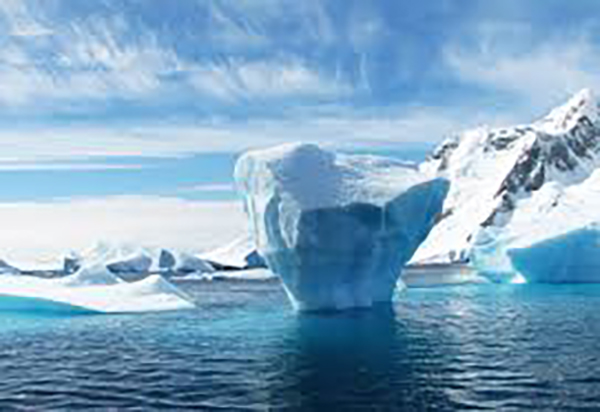

冰山的密度較海水的密度低,所以它在海水中會浮。
An iceberg floats on sea water since it is LESS dense than sea water.
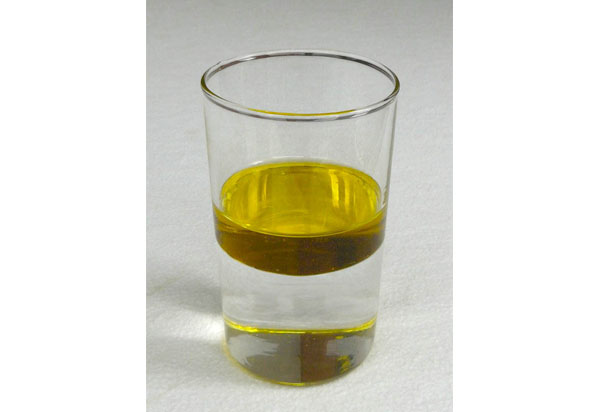

油的密度較水的密度低,所以它浮在水之上。
Oil floats on water since it is LESS dense than water
下圖中,膠泥球在水中會沉,因為它的密度較水為高。但膠泥球被搓成「小船」後卻可浮於水,這是由於「小船」內載有大量空氣,而空氣的密度遠較水的低,因此,「小船」( 船身 + 空氣) 的整體密度較水的低,於是「小船」便會浮於水。這也是帆船能浮在水中的原理。
In the diagram below, the plasticine ball sinks as it is denser than water, but the plasticine ‘boat’ can float on water. This is because the plasticine ‘boat’ contains a large volume of air, which is far less dense than water. Therefore, the overall density of the ‘boat’ is lower than the density of water, and the ‘boat’ can float on water.
船的航行速率與作用在船上的力Speed of the boat and the force acting on it
距離、時間和速率
Distance, time and speed
速率描述物體移動的快慢。物體的速率是每單位時間內所移動的距離,它的單位是米每秒(m s-1)或公里每小時(km h-1)。例如,我們步行的速率大約是1.1 m s-1或4.0 km h-1。物體移動得愈快,它的速率便愈高。
物體移動時,它的速率可能會改變。假如我們知道物體在特定時間內所移動的距離,便可用以下公式找出物體的平均速率:
Speed describes how fast an object moves. The speed of an object is the distance travelled by the object per unit time. Its unit is metre per second (m s-1, also known as m/s) or kilometre per hour (km h-1, also known as km/h). For example, our walking speed is about 1.1 m s-1 or 4.0 km h-1. The faster an object moves, the higher its speed.
An object’s speed may change while it is travelling. If we know the distance travelled by an object during a period of time, we can find the average speed of the object using the following formula:
作用在帆船上的力
Force acting on a boat
力能改變物體運動的速率和方向。順風時,風力直接作用在船帆上作為推動力。逆風時,風力與船帆並不平行,只有一部分的風力能推動帆船,使帆船以「之字形」路徑行走。
Forces can change the travelling speed and direction of an object. When following wind (順風), the wind force directly acts on the sail as a driving force. When against the wind (逆風), the wind force is not parallel to the sail, only part of the force acts as the driving force and the boat will move in a ‘zigzag’ path.
試想想Think about
如圖所示,在小帆船加上一把風扇,啟動風扇後,帆船並不會向前移動,而是保持靜止不動,為甚麼?
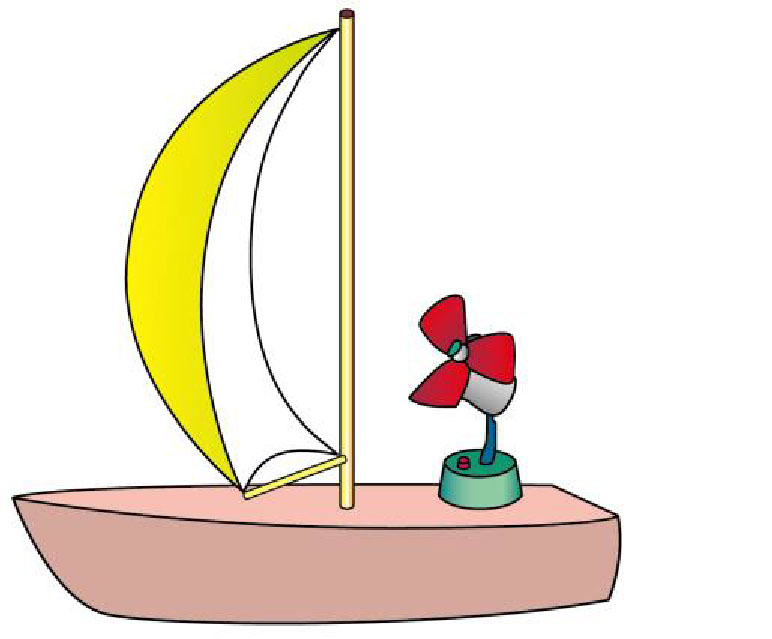
As shown in the figure, if we add a small fan on a sailboat and turn it on, the boat will remains at rest. Why?

歷史History
認識航海大發現The Voyages of Discovery
航海大發現The Voyages of Discovery
「航海大發現」是指十五至十六世紀期間,由歐洲人發起的一系列航海探險活動。在這百多年間,歐洲航海家開闢出多條新航路及發現了多片未知的地域,並證實「地圓說」(即地球是圓的說法)的真確性。這些發展不但令東西方接觸日益頻繁,更為西方以至全世界帶來重大的轉變。
The Voyages of Discovery refer to the naval explorations made by Europeans in the 15th and 16th centuries. During these years, European navigators sailed to distant unknown places many times. They opened up new sea routes to the East, discovered many previously unknown lands and proved that the Earth was round. The Voyages of Discovery increased East-West encounters and led to great changes in the West and other parts of the world.
航海時代的先行者Pioneers of the Voyages of Discovery
葡萄牙與西班牙是第一批展開探索新航路的歐洲國家。自十五世紀開始,葡萄牙航海家先是沿着非洲西岸南下,繞過好望角後繼續往東,途徑東非、阿拉伯半島、印度,更一度到達中國與日本。而西班牙的航海家則在開拓新航線時,意外發現美洲大陸,後來幾乎整個中、南美洲都成為了它的殖民地。繼葡、西兩國後,荷蘭、英國與法國等亦相繼派遣航海家探索通往亞洲的新航線。
Portugal and Spain were the first European countries to explore new sea routes. In the 15th century, Portuguese navigators sailed down the western coast of Africa. They rounded the Cape of Good Hope and sailed eastwards, passing through East Africa, the Arabian Peninsula and India. They even reached China and Japan. Spanish navigators discovered the American continent by accident while exploring new sea routes. Later, Spain colonized nearly the entire Central and South America. The Netherlands, Britain and France also sent navigators to explore new sea routes to Asia.
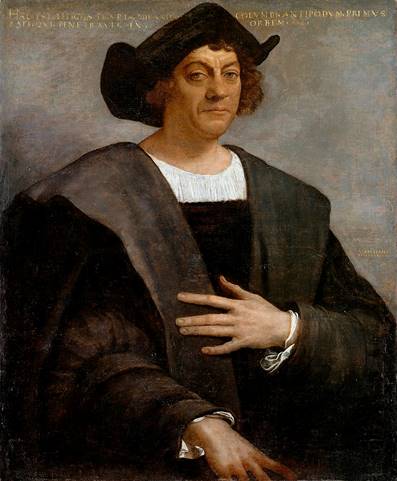

發現新大陸的哥倫布
Christopher Columbus
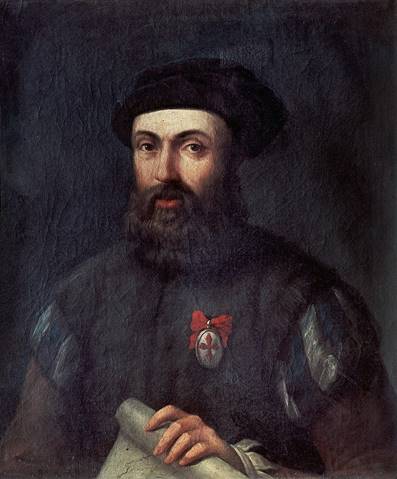

首位完成環球航行的麥哲倫
Ferdinand Magellan
航海時代的帆船Sailboat in the Voyages of Discovery
克拉克帆船(Carrack)是大航海時代最為盛行的船形,由三個桅杆與五個船帆組合而成,船身上設置有三角船帆和四角船帆。帆船龐大的體積及堅固的船身令它可在大海中保持平穩,並抵擋強烈風暴,所以非常適合展開遠航。
1492年,意大利航海家哥倫布(Christopher Columbus)在西班牙王室的贊助下,率領三艘船橫渡大西洋,卻意外發現了美洲新大陸,揭開了歐洲人殖民美洲的序幕。
哥倫布於發現新大陸時,船隊三艘船中,名為「聖瑪莉亞號」(Santa María)的旗艦便是一艘克拉克帆船。1492 年12 月25 日,聖瑪莉亞號意外觸礁,哥倫布只好被迫棄船。
Carracks were the most popular ships during the Voyages of Discovery. They had three masts and five sails. There were triangular and quadrangular sails. They could sail stably in heavy seas and storms because of their huge size and sturdy hull. They were very suitable for ocean-going voyages.
In 1492, Italian navigator Christopher Columbus, supported by the monarchs of Spain, departed from Spain with three ships. His fleet sailed across the Atlantic Ocean and accidentally discovered the new continent of America. This started the European colonization of the Americas.
Santa Maria, the flagship of Columbus’ fleet, was a carrack. On December 25, 1492, Santa Maria was wrecked. Columbus was forced to abandon the ship.
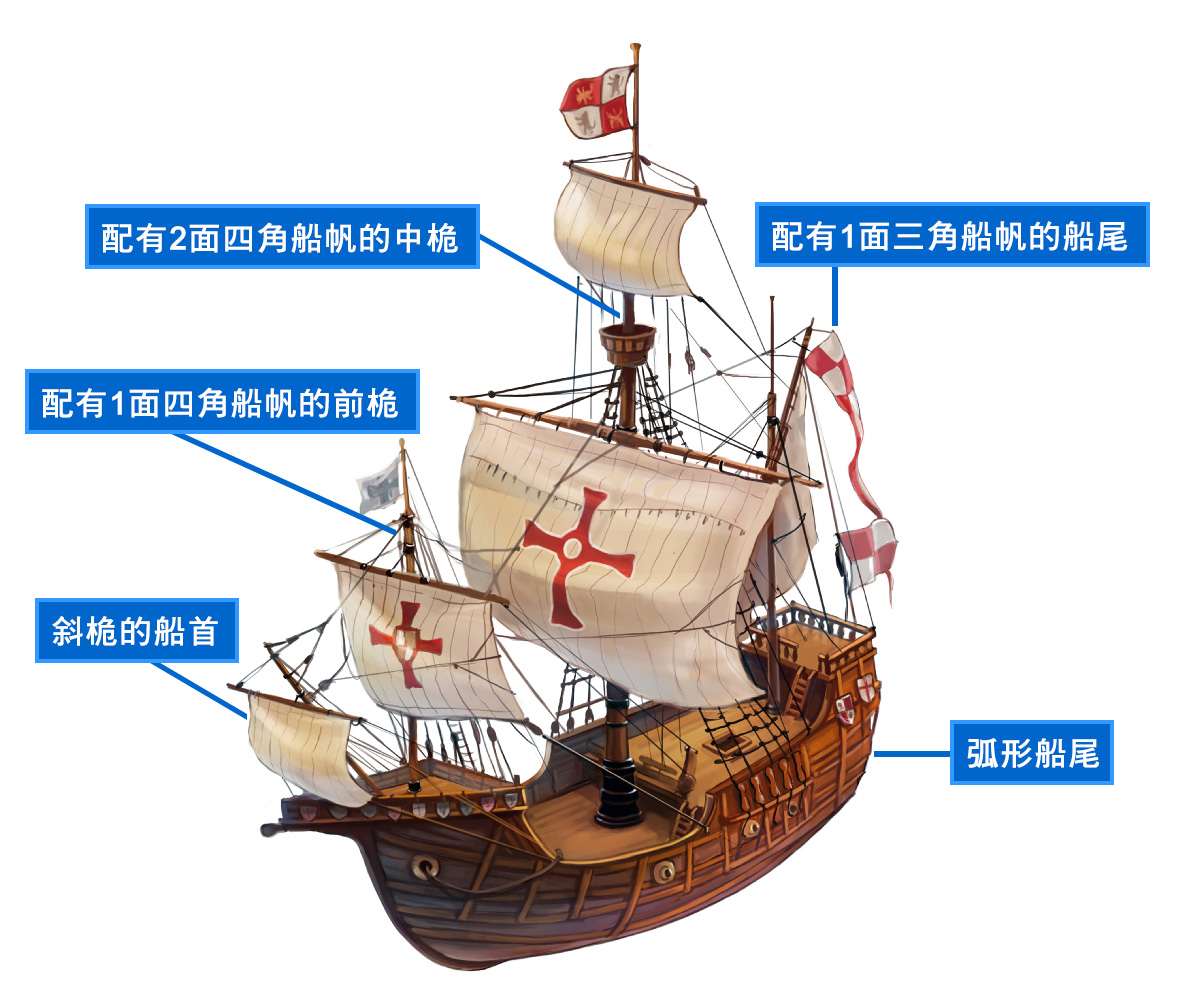
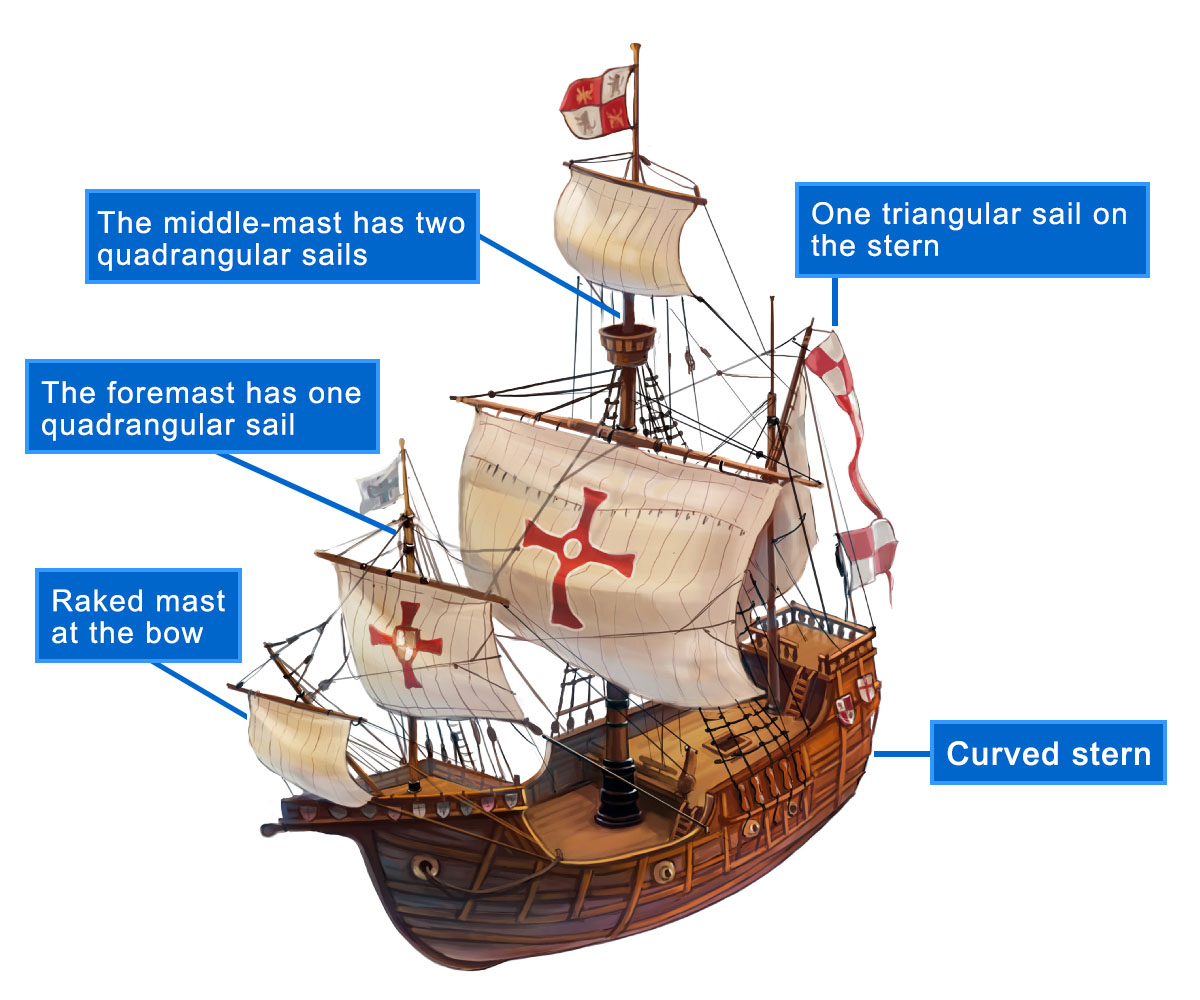
聖瑪莉亞號Santa Maria
試想想Think about
1.
除了造船與航海技術的進步,試從課文或網上搜集資料,探討推動「航海大發現」的其他因素。
Apart from improvements in shipbuilding and navigation, find out the other causes of the Voyages of Discovery from the textbook and the Internet.
2.
十五至十六世紀期間,葡萄牙是最早發展遠程航海的國家,試從網上找尋資料,解釋推動葡萄牙發展遠程航海的歷史因素。
Portugal was the first country to start ocean-going voyages in the 15th and 16th centuries. Try to find out the historical factors that promoted Portugal to start these voyages on the Internet.
DIY方法一DIY method 1
所需物料︰
| 竹籤 | ~5 |
| 膠瓶 | 1 |
| 棉線 | 1 |
| 剪刀 | 1 |
| 美工刀 | 1 |
| 瓶蓋 | 1 |
| 白布 | 1 |
| 膠水 | |
Materials:
| Bamboo stick | ~5 |
| Plastic bottle | 1 |
| Cotton thread | 1 |
| Scissors | 1 pair |
| Cutter | 1 |
| Bottle cap | 1 |
| White cloth | 1 |
| Glue | |
製作步驟:
Procedures:
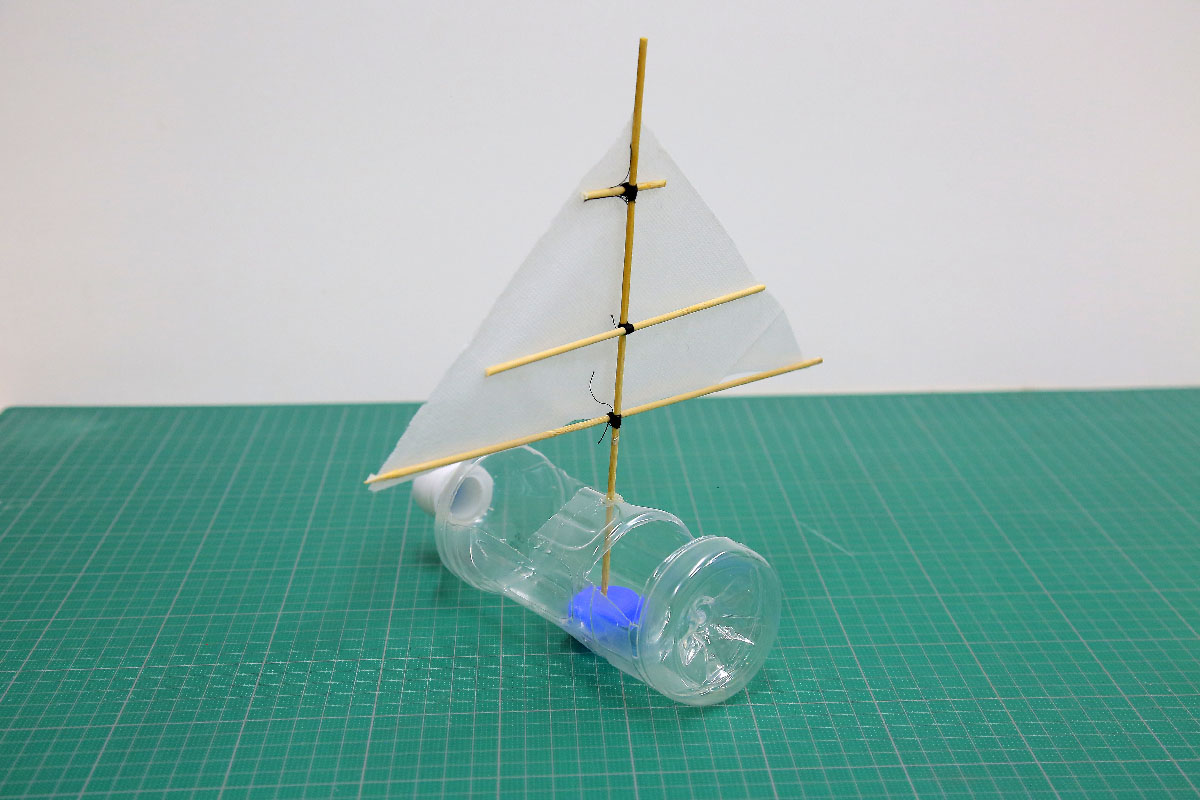
背面Back
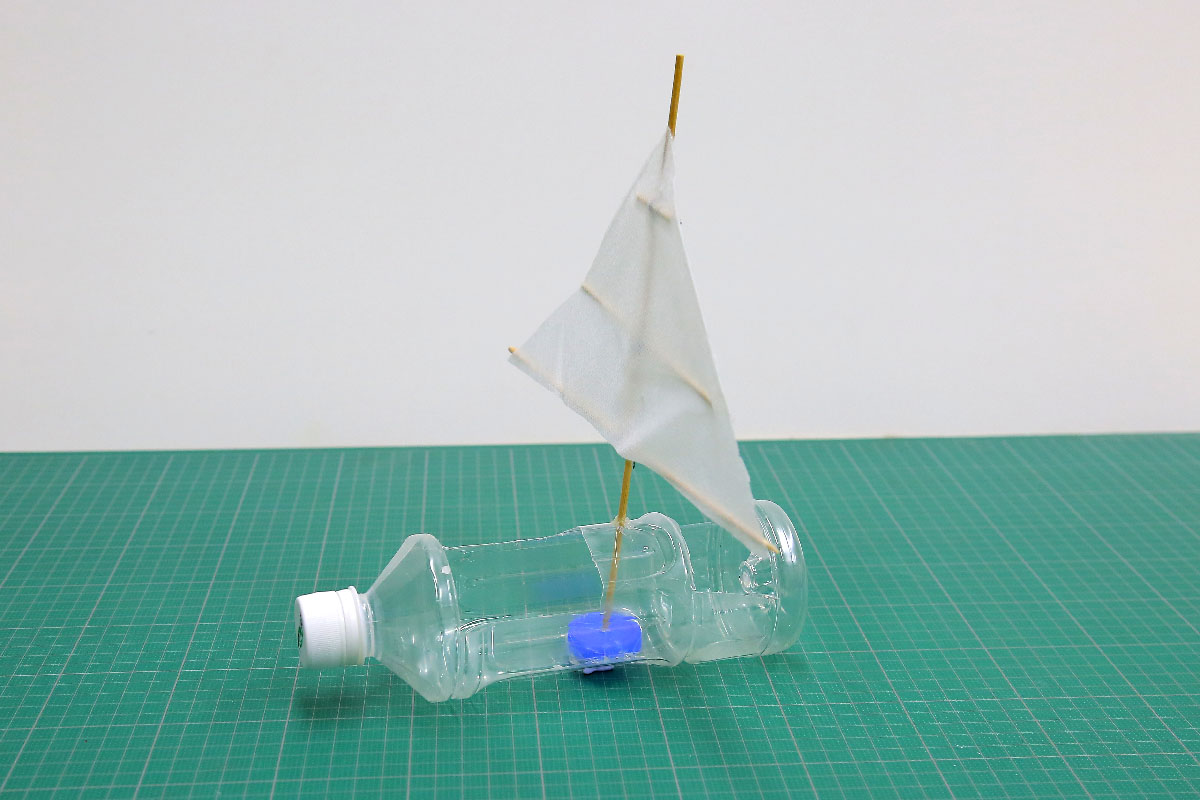
側面Flank
DIY方法二DIY method 2
所需物料︰
| 飲管 | ~2 |
| 紙包飲品盒 | 1 |
| 卡紙 | 1 |
| 打孔機 | 1 |
| 剪刀 | 1 |
| 膠紙 | 1 |
Materials:
| Straw | ~2 |
| Drink carton | 1 |
| Card | 1 |
| Hole punch | 1 |
| Scissors | 1 pair |
| Adhesive tape | 1 |
製作步驟:
Procedures:
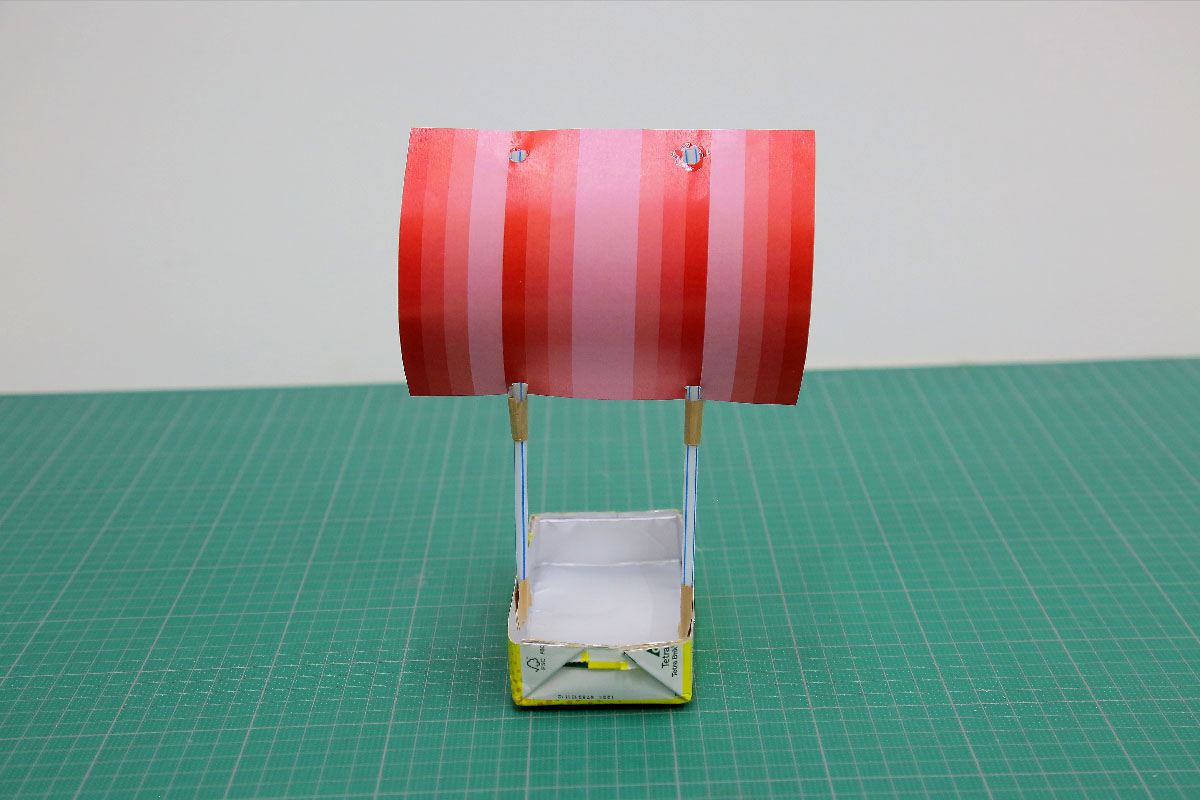
正面Front
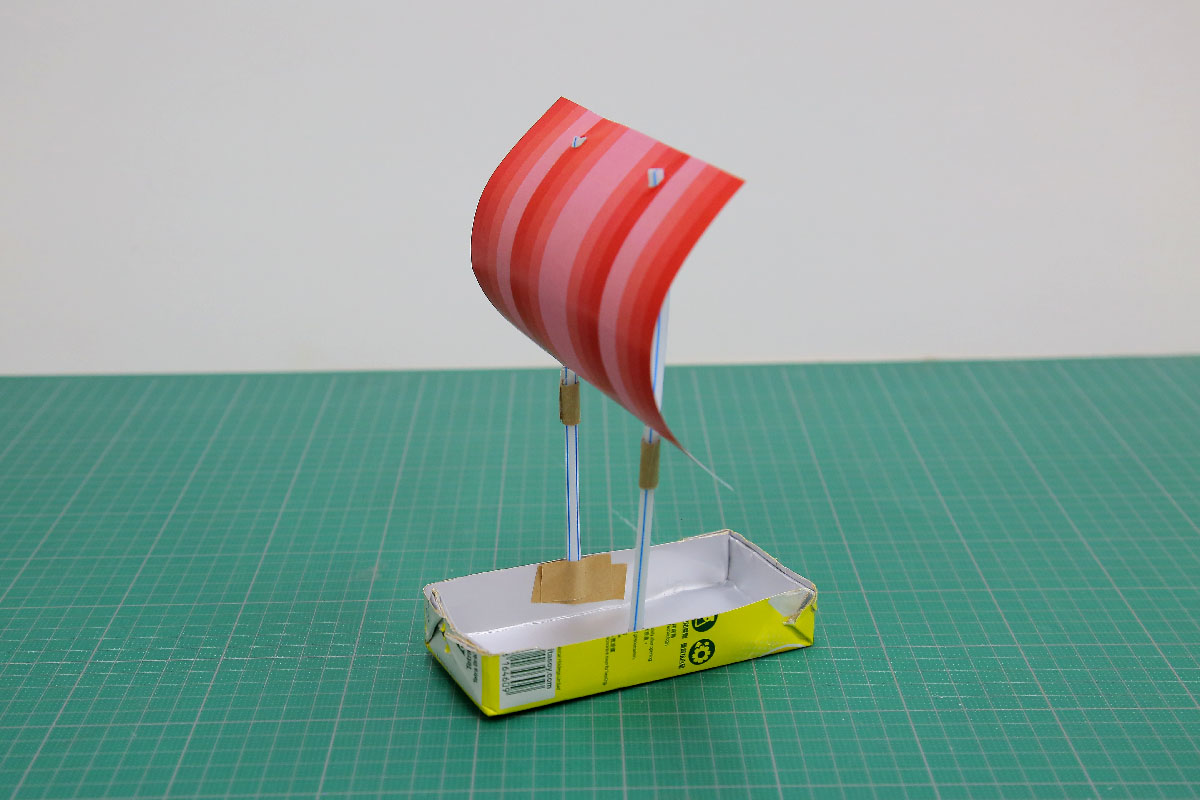
側面Flank
DIY方法三DIY method 3
所需物料︰
| 木條 | ~50 |
| 竹籤 | 1 |
| 卡紙 | 1 |
| 剪刀 | 1 |
| 膠水 | |
| 寶貼萬用膠 | |
Materials:
| Wooden stick | ~50 |
| Bamboo stick | 1 |
| Card | 1 |
| Scissors | 1 pair |
| Glue | |
| Blu-Tack reusable adhesive | |
製作步驟:
Procedures:
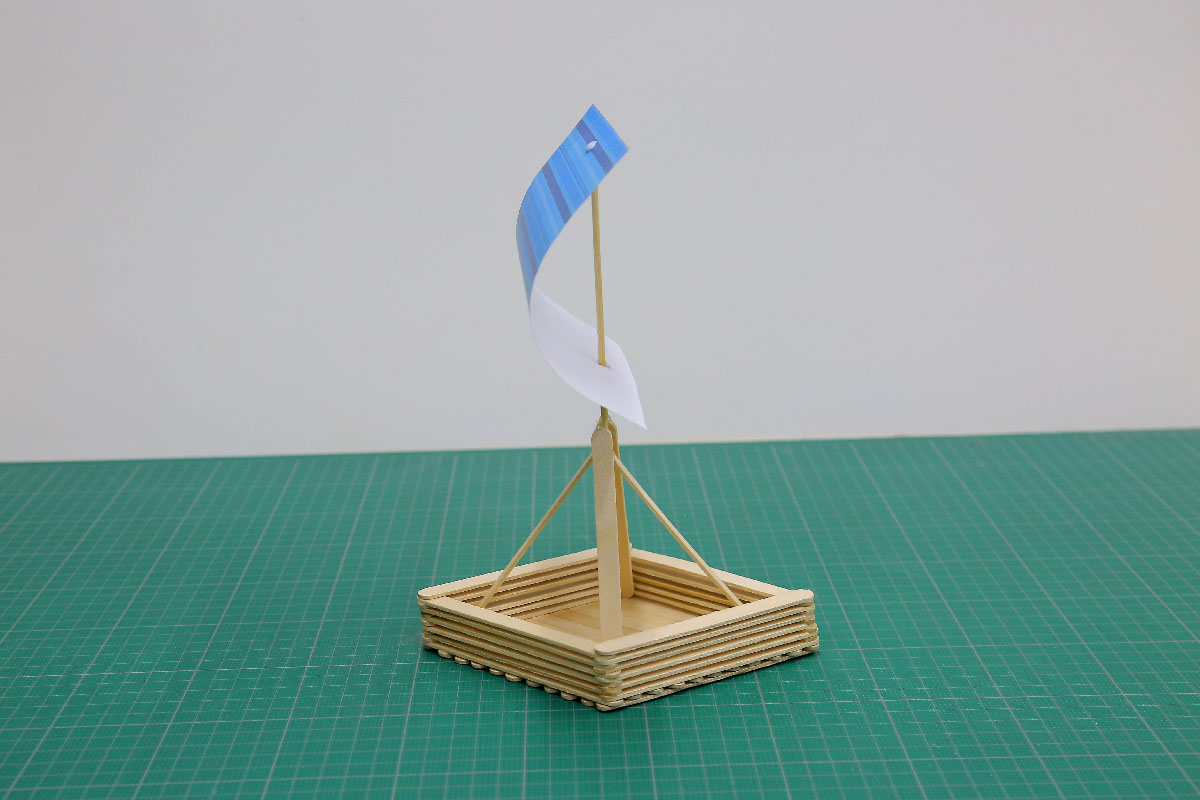
側面Side
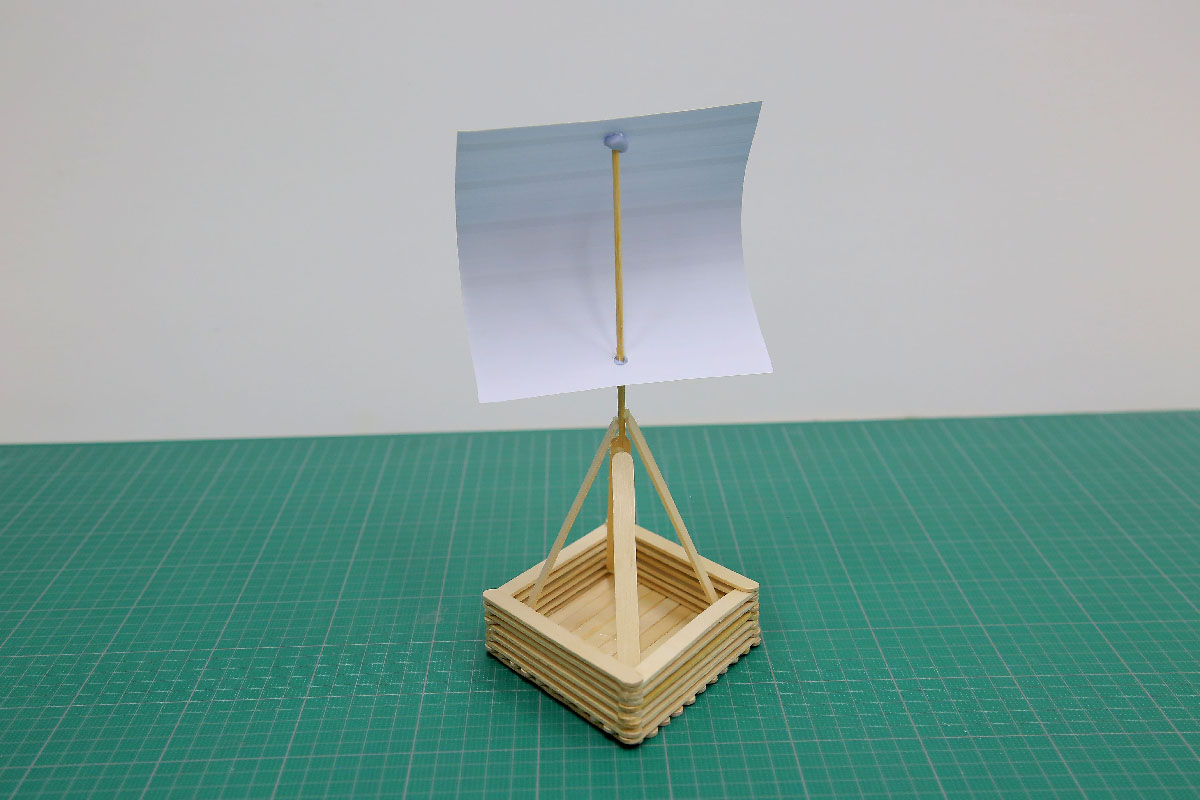
背面Back
比賽一Competition 1
現在,學生可以參考和改良上述的方法,並融合自己的創意與設計,製作帆船以參加比賽!
Now, students can make a sailboat to take part in a competition. Students can improve the previous methods and design the boat using creativity.
遊戲1﹕載重Game 1: Load-bearing capacity test
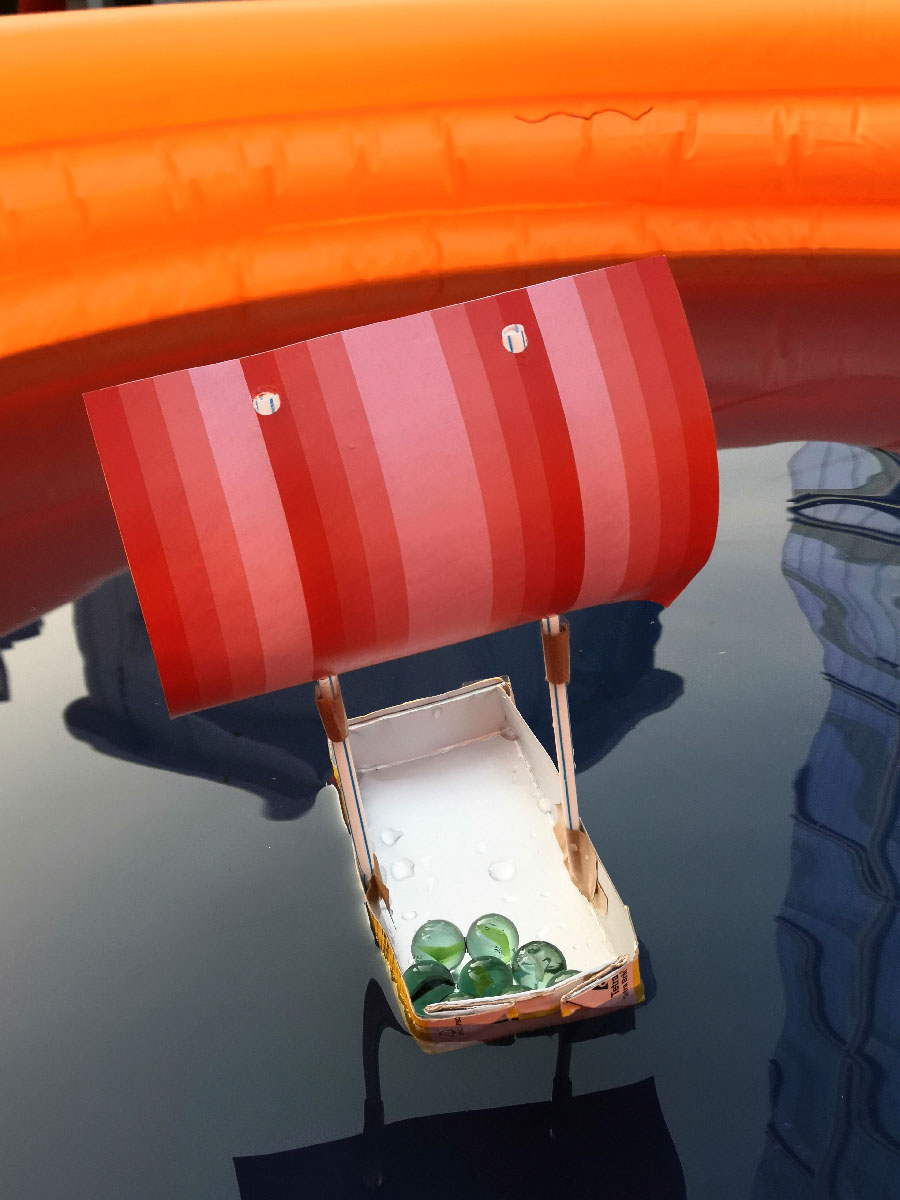
準備物件:Props needed:
- Inflatable pool filled with water
- Toy marbles
- DIY sailboats
玩法:How to play:
- 各組自行把波子逐一加到帆船上,直至船入水或沉沒
- 能夠承載最多波子的組別獲勝
- Members of each group load the toy marbles onto their sailboat until it sinks.
- The boat that carries the most marbles wins the game!
Which sailboat can carry the most marbles?
附加資源 1Additional Resource 1
編程Computer programming
Scratch 是一套網上電腦程式開發平台,學生可在 Scratch 上學習編寫電腦程式、遊戲、動畫或互動程式等。試參考以下預製的 Scratch 程式及資源組件,並依指引製作一個簡單的帆船遊戲。
Scratch is an online computer programming platform where you can programme your own interactive stories, games and animations. Create a simple sailboat game with reference to the following Scratch guidelines.
使用 Scratch 製作帆船遊戲編程指引:
下載
Guidelines for creating sailboat games with Scratch:
Download
步驟 1Step 1
- Design a sprite and set the controls.
進階編程例子Advanced programming example
- 有興趣的同學可參閱進階編程例子,學習製作更複雜的遊戲
- Students may refer to this example to learn how to create a more advanced game.
附加資源 2Additional Resource 2
立體打印3D printing
如果學校有立體打印機,老師和學生可以在本社網站下載可供立體打印的模型。如果你會使用立體製圖軟件(例如
Blender),更可設計和製作自己的立體打印模型。
Teachers and students can download the file of the model for 3D printing from our website. If you are familiar with 3D graphic tools (e.g.
Blender), you can also design your own models by modifying the file.